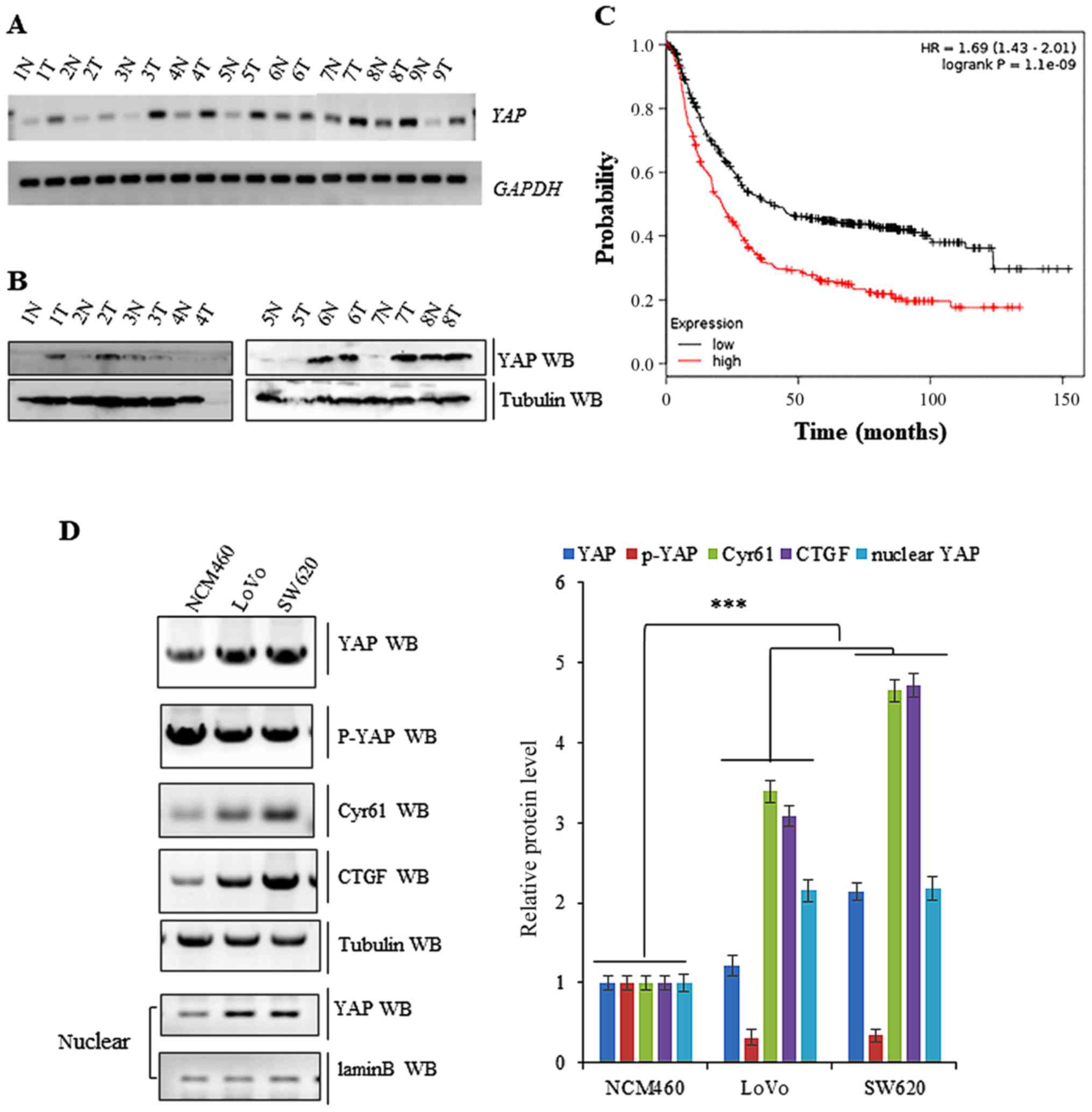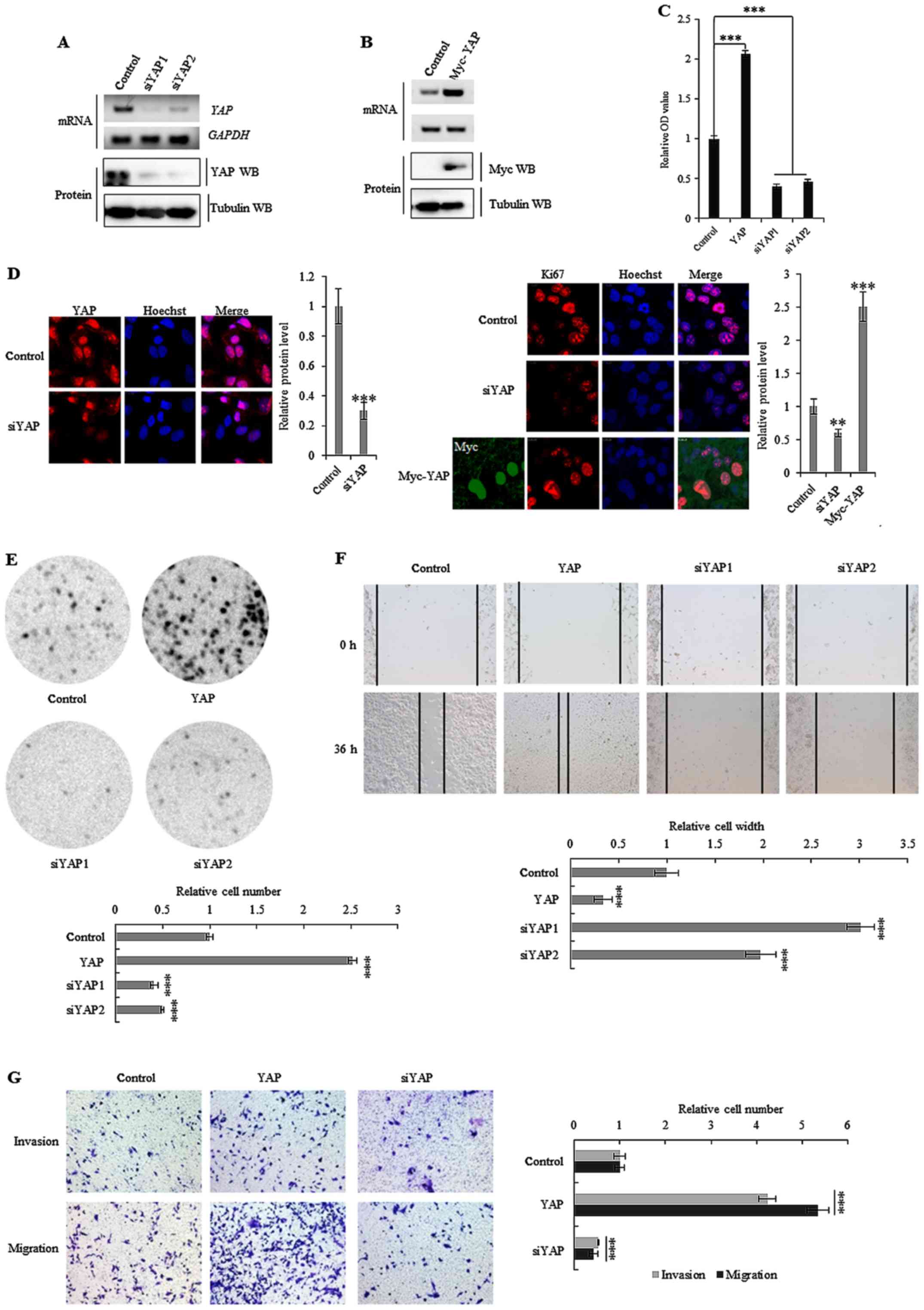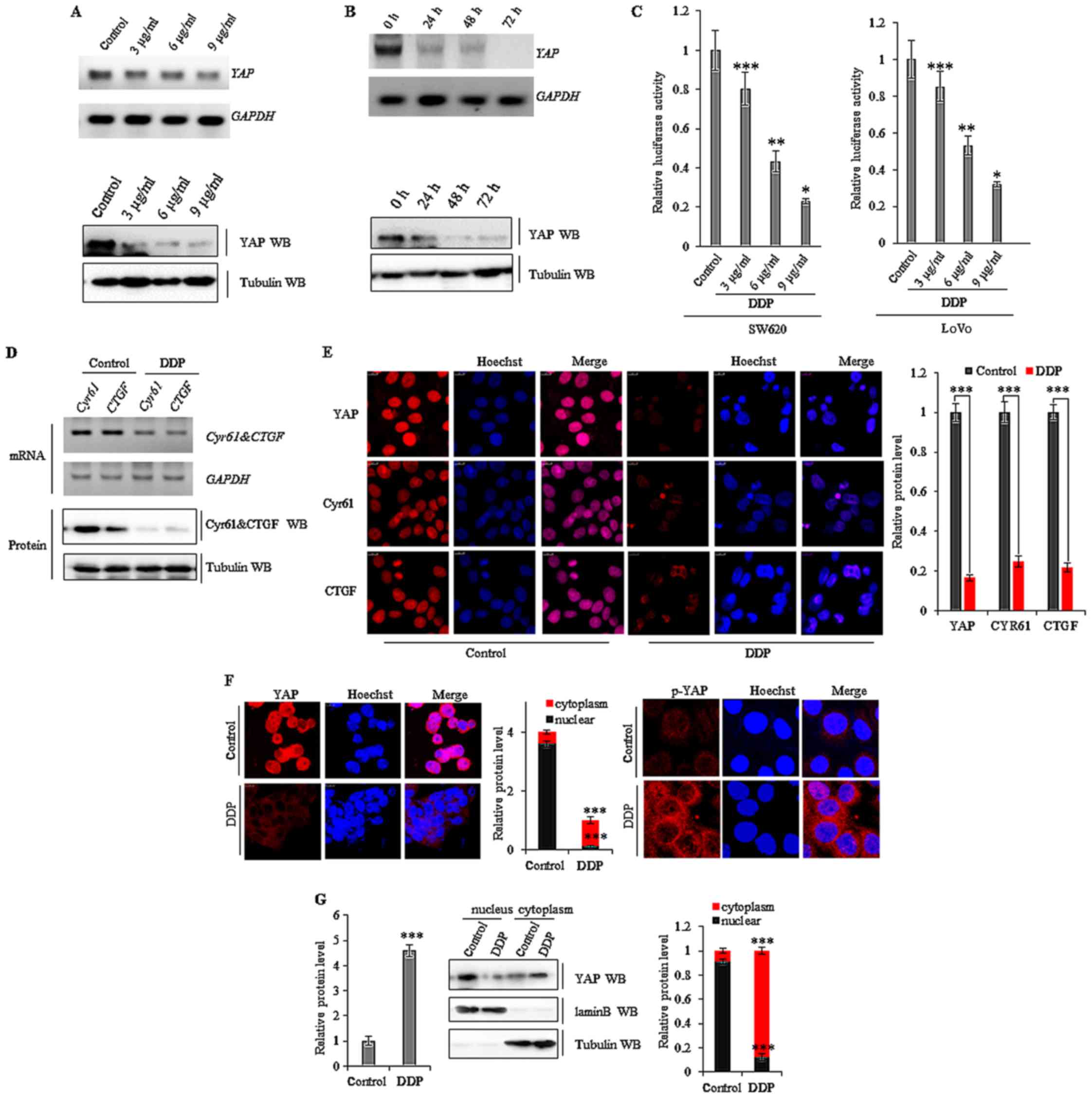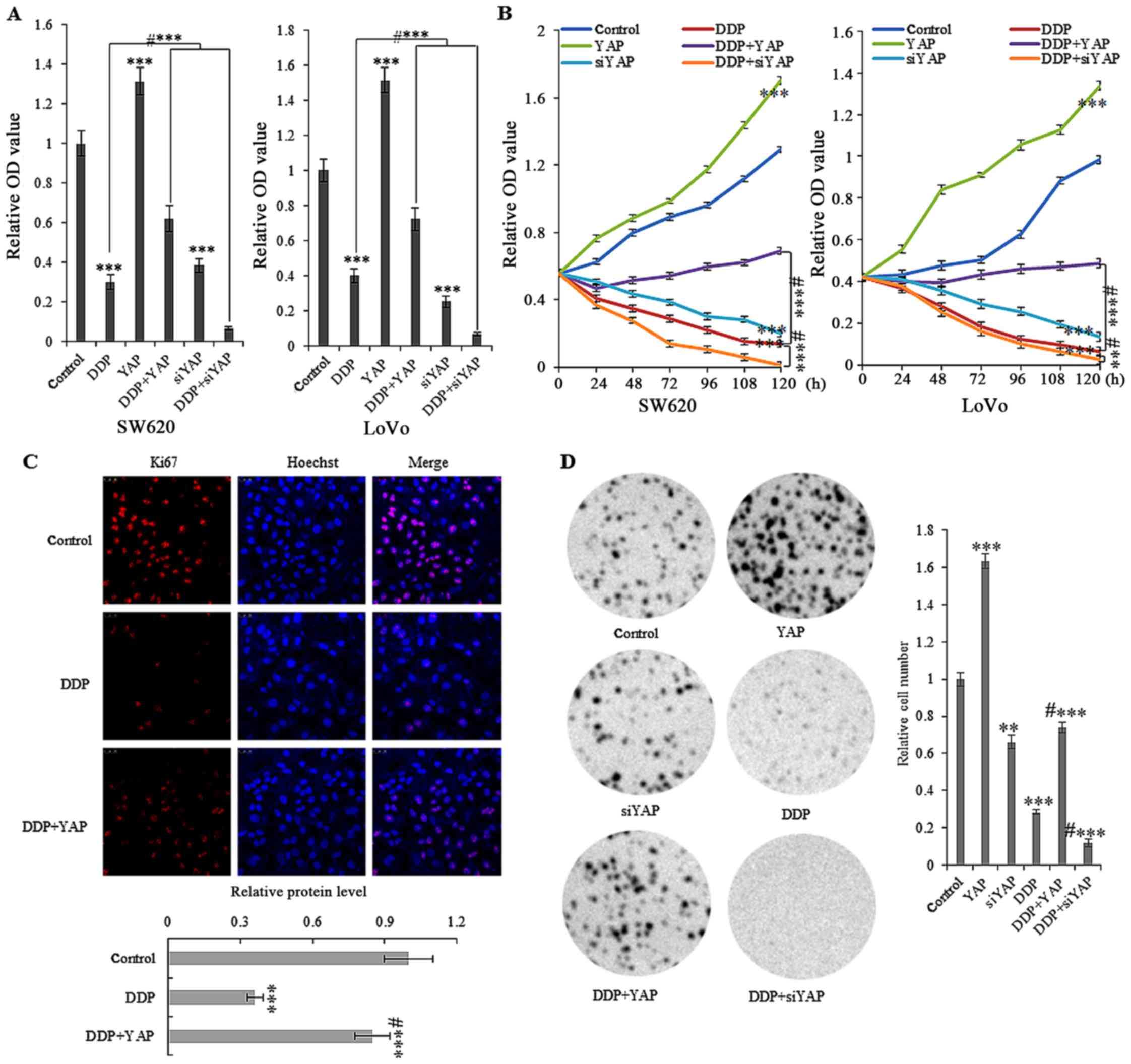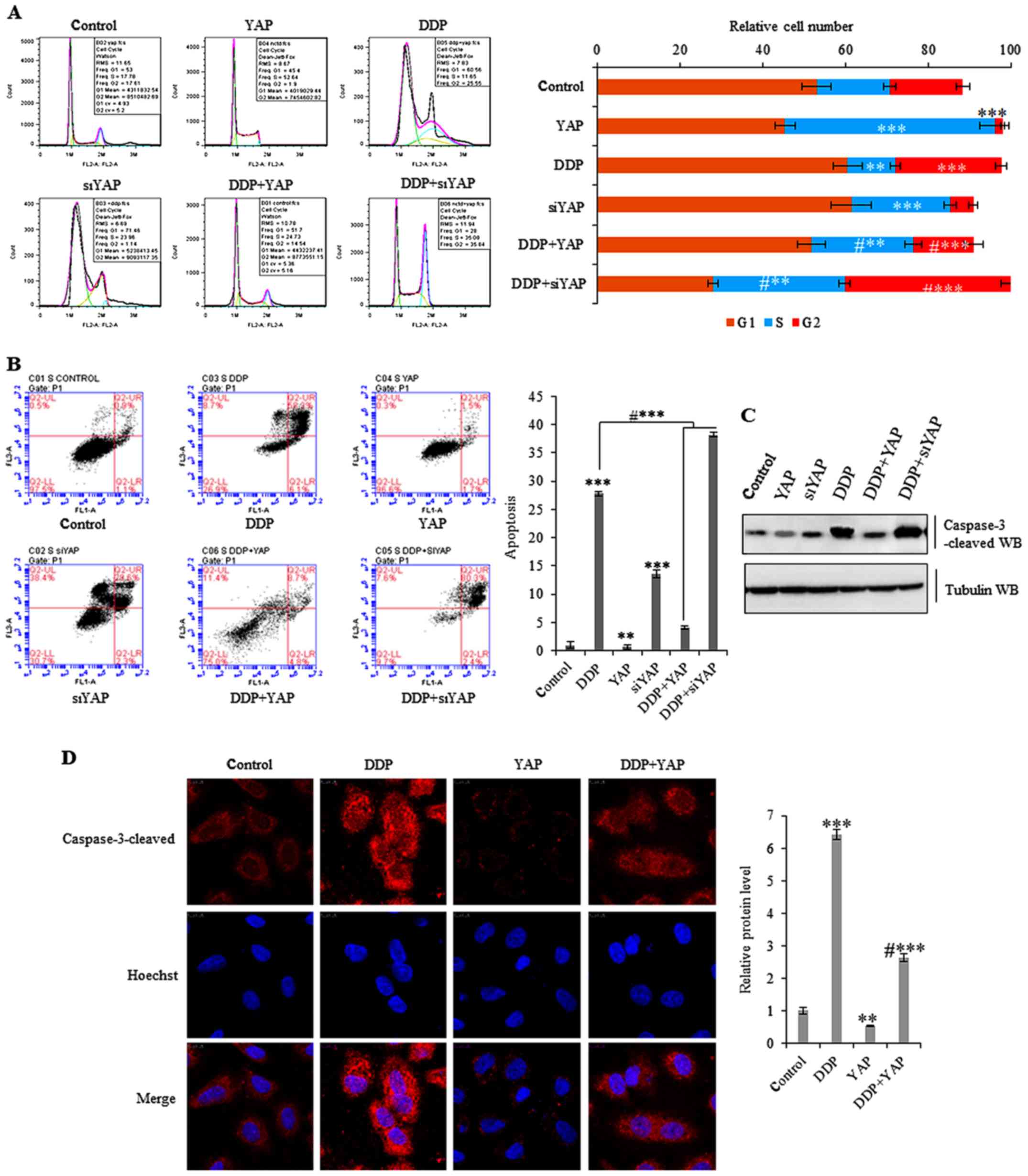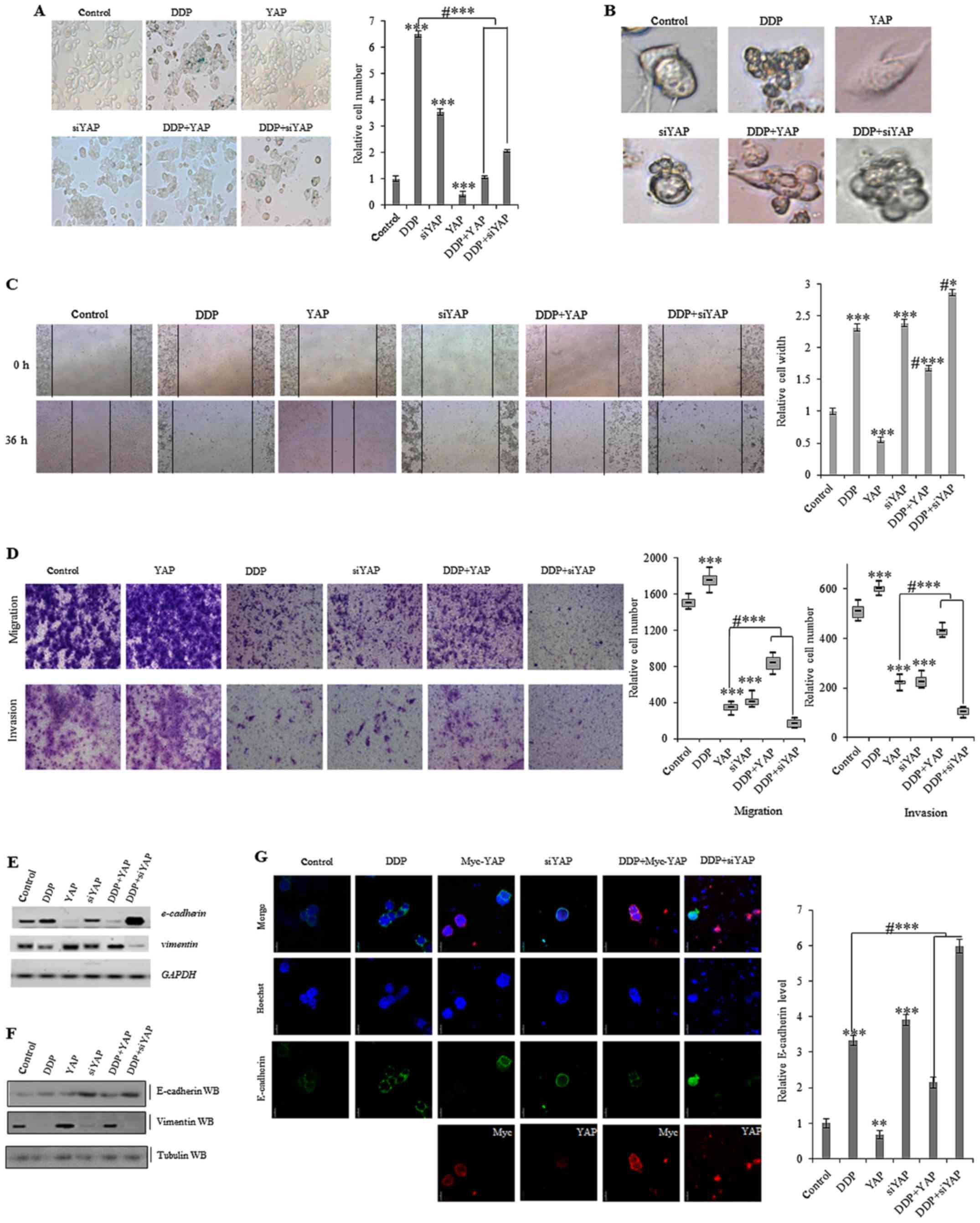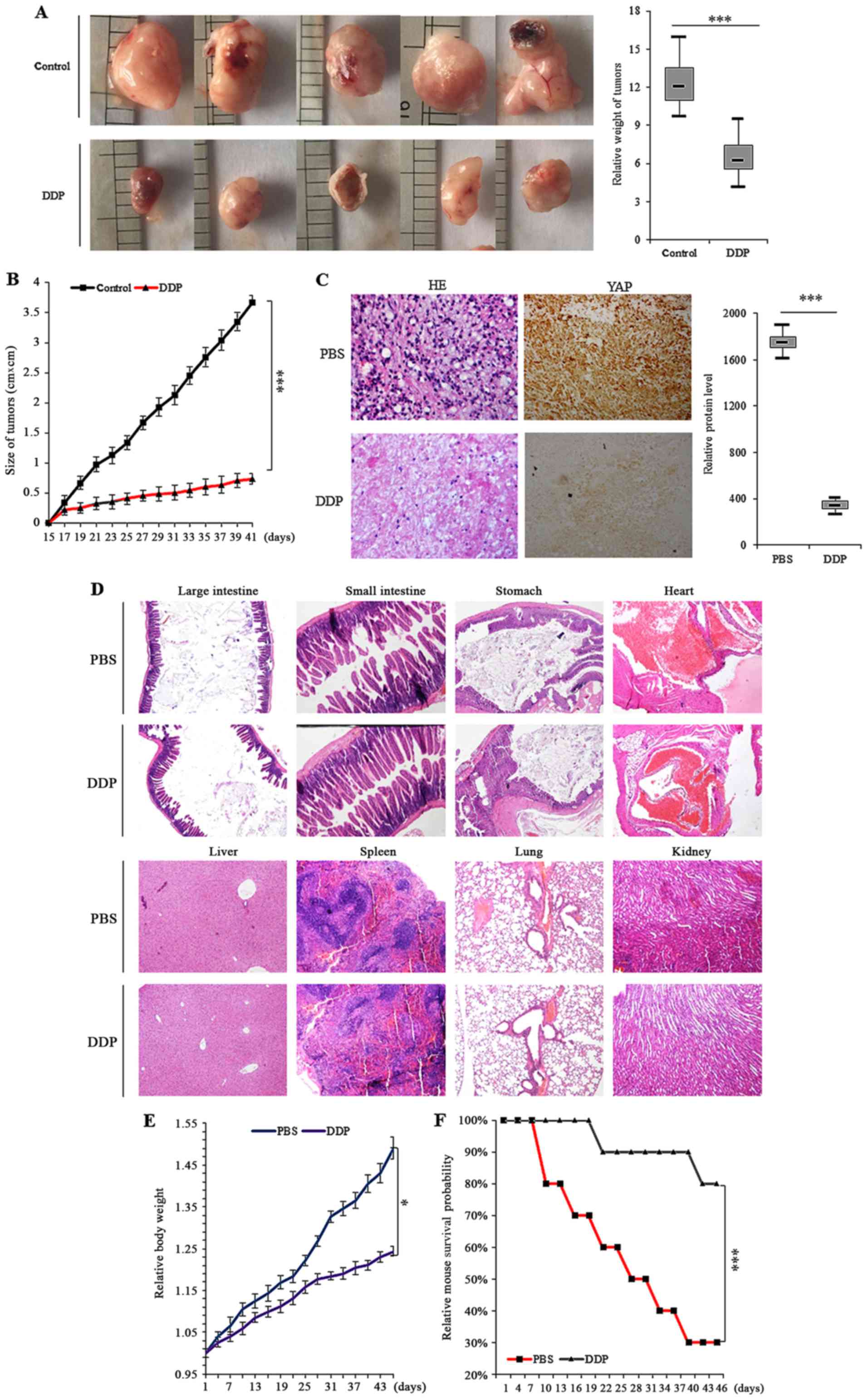Suppression of YAP by DDP disrupts colon tumor progression
Retraction in: /10.3892/or.2020.7843
- Authors:
- Published online on: March 6, 2018 https://doi.org/10.3892/or.2018.6297
- Pages: 2114-2126
-
Copyright: © Li et al. This is an open access article distributed under the terms of Creative Commons Attribution License.
Abstract
Introduction
Colon cancer is one of the most frequently diagnosed cancers worldwide and has a particularly poor prognosis for patients (1). Despite the development of some novel-targeted therapies, chemotherapy to inhibit and damage cancer cells using chemicals such as cisplatinum remains one of the most common treatment options for colon cancer. However, chemotherapy is often indiscriminate, with many off-targeted toxic effects and is typically only used to treat colon cancers in the early stages of the disease. During this period, cancer cells often acquire drug resistance due to increased exposure to stressful conditions and cytotoxic drugs (2). This resistance is an important obstacle to treatment that can result in chemotherapy failure in many cancers, including colon cancer (3). Therefore, the identification of safe and effective agents that specifically target drug-resistant cancers, is vital for the future treatment of colon cancer (4–6).
Due to the inevitable and often rapid development of drug resistance to colon cancer chemotherapies, there has been some research investigating the possible underlying mechanisms. For example, the aberrant activation of the Mst/Yap-signaling pathway has been revealed to correlate with drug tolerance acquired during the treatment of colon cancer patients using cisplatin (DDP) and erlotinib, an epidermal growth factor receptor (EGFR) inhibitor (7). However, the role of the Mst/Yap pathway in the development of drug resistance is poorly understood in human colon cancers. Functionally, the Mst/Yap pathway is highly conserved in both humans and Drosophila and has a key role in regulating growth (8,9). The tumor suppressor mercaptopyruvate sulfurtransferase (MPST or MST) and a subsequent kinase cascade, act to negatively regulate YAP, an oncoprotein involved in cell growth and survival that functions by transcriptionally regulating various downstream target genes (10). MST is also one of the core suppressor molecules in the Hippo signaling pathway and is phosphorylated and activated by various upstream signaling proteins. Salvador family WW domain-containing protein 1 (SAV1 or WW-45) is another core component of the Hippo signaling pathway and activated MST combines with SAV1 to phosphorylate and activate the large tumor suppressor 1 (LATS1) kinase. Activated LATS1 binds with the MOB kinase activator MOB1 to phosphorylate YAP and this phosphorylated protein is retained in the cytoplasm through interactions with the 14–3–3 family of proteins. By preventing movement to the nucleus, YAP is prevented from combining with other transcription factors to inactivate target promoters (11–14). However, without the suppressive functions of MST, unphosphorylated YAP gathers in the nucleus and interacts with transcriptional enhancer factor domain (TEAD) transcription factors. This in turn regulates the Mst/Yap pathway via downstream genes that include cysteine rich angiogenic inducer 61 (CYR61), connective tissue growth factor (CTGF), survivin (BIRC5) and cyclin D1 (CCND1) (15–18).
The chemotherapeutic agent DDP is one of the most extensively used agents for the treatment of cancer. In 1972, it became the first metal-based drug to enter clinical trials and was initially applied in a clinical setting in 1979 (19). DDP is now a gold standard drug used for the treatment of testicular cancer (for which it has a 90% cure rate) and also for the treatment of head and neck, cervical, breast, lung, ovarian, gastric and bladder cancers, among many others (20,21). DDP exerts its antitumor activity through its alkylating properties. Once the drug enters the cytoplasm of a cell, chloride ligands are spontaneously and sequentially replaced with water molecules due to the fact that the chloride concentration of the cytoplasm is much lower than that of the blood. This results in the formation of positively charged bis-aquated platinum complexes that bind to DNA (22–25). DDP predominantly forms intra-strand adducts between two adjacent guanines that are followed by an adjacent guanine and adenine. These adducts cause the DNA helix to bend by up to 60% towards the major groove and unwind, inhibiting further DNA replication and transcription. This ultimately leads to cell death (21,26,27). However, the continuing clinical success of DDP is hindered by two major limitations, the development of DDP-resistant cancer cells and the toxic side-effects of the drug. These mechanisms act in tandem, so that when cells become resistant to DDP, the subsequent dose must be increased. This in turn increases the severity of toxic side-effects. These side-effects are primarily due to the dose-limiting effects of the drug on neurotoxicity and ototoxicity, although other common side-effects include severe nausea, vomiting, gastrotoxicity and myelosuppression (28–31).
To further investigate the role of YAP in cancer drug resistance and to validate DDP as a colon cancer therapy, we examined how DDP suppresses the Mst/Yap signaling pathway and the mechanism through which this leads to the inhibition of colon carcinoma progression and metastasis. Our data demonstrated that DDP specifically suppressed the expression of YAP and had various downstream effects on transcription. In addition, we confirmed that DDP has the potential to be used as a treatment for colon cancer. These data improved our understanding of the Mst/Yap pathway and its role in cancer progression and may lead to improved outcomes for patients.
Materials and methods
Molecular biology
Flag-tagged YAP constructs were made using the pcDNA 3.1 vector (Invitrogen, Carlsbad, CA, USA). Sequences encoding the Flag epitope (DYKDDDDK) were added by PCR through the replacement of the first Met-encoding codon in the respective cDNA clones.
Cell culture and transient transfection
Human colon cancer cells SW620, LoVo and NCM460 obtained from the American Type Culture Collection (ATCC; Manassas, VA, USA) were cultured in Dulbecco's modified Eagle's medium (DMEM) supplemented with 10% fetal bovine serum (FBS; Hyclone Laboratories, San Angelo, TX, USA) in an incubator, at 37°C under a mixture of 95% air and 5% CO2. Plasmids were transfected using polyethylenimine (PEI) reagent, following the manufacturer's instructions.
Western blot analysis
SW620 and LoVo colon cancer cells were transfected with the relevant plasmids and cultured for 36 h. For western blot analysis, the cells were lysed in NP-40 buffer (10 mM Tris pH 7.4, 150 mM NaCl, 1% Triton X-100, 1 mM EDTA pH 8.0, 1 mM EGTA pH 8.0, 1 mM PMSF and 0.5% NP-40) at 25°C for 40 min. The lysates were added to 5X loading dye and then separated by electrophoresis.
Antibodies
The primary antibodies used in the present study were rabbit anti-Flag (1:1,000, cat. no. sc-166355; Santa Cruz Biotechnology, Inc., Dallas, TX, USA), anti-pYap (cat. no. 14074) and anti-Yap (cat. no. 13008) (1:1,000; Cell Signaling Technology, Inc., Danvers, MA, USA), anti-vimentin (cat. no. ab92547), anti-E-cadherin (cat. no. ab1416) and anti-cleaved capase-3 (1:1,000, cat. no. ab2302; all from Abcam, Cambridge, UK).
Immunofluorescent staining
To examine the subcellular localization of YAP, the SW620 cells were exposed to DDP for 36 h, seeded onto coverslips in a 24-well plate, and left overnight. The cells were then fixed using 4% formaldehyde for 30 min at 25°C and treated with 2% bovine serum albumin (BSA) in phosphate-buffered saline (PBS) for 30 min. The coverslips were incubated with rabbit anti-YAP monoclonal antibody (Cell Signaling Technology, Inc.) at 1:200 dilution in 3% BSA. The coverslips were then incubated with an Alexa Fluor 594 (red, cat. no. R37117; Invitrogen; Thermo Fisher Scientific, Inc., Waltham, MA, USA) tagged anti-rabbit monoclonal secondary antibody at 1:1,000 dilution in 3% BSA. DAPI (3 µg/ml) was added for nuclear counterstaining. Images were captured with a Zeiss Axio Imager Z1 fluorescence microscope (Carl Zeiss AG, Oberkochen, Germany).
Cell flow cytometry assays
DDP-treated and control cells at 80% confluency were harvested and fixed with 70% ethanol. These were then stained using propidium iodide (PI) and the cell cycle stage was assessed by flow cytometry. To evaluate apoptosis, the cells were cultured at 80% confluency, trypsinized and stained with a PI/Annexin V Apoptosis Detection kit (Vazyme, Jiangsu Sheng, China). The data were collected and analyzed on a BD FACScan flow cytometer using FACS software (BD Biosciences, San Jose, CA, USA).
RNA isolation and real-time reverse transcription (RT)-PCR assay
We used TRIzol reagent (TransGen Biotech, Beijing, China) to isolate total RNA from the samples. RNA was reverse transcribed into first-strand cDNA using a TransScript All-in-One First-Strand cDNA Synthesis kit (TransGen Biotech). cDNAs were used in a real-time RT-PCR assay with the human GAPDH gene as an internal control. The RT-PCR primers were: E-cadherin forward, ACCATTAACAGGAACACAGG and reverse, CAGTCACTTTCAGTGTGGTG; YAP forward, GGACCCCAGACGACTTCCTCAACAG and reverse, CCTTCCAGTGTGCCAAGGTCCACAT; CYR61 forward, GGTCAAAGTTACCGGGCAGT and reverse, GGAGGCATCGAATCCCAGC; CTGF forward, AATGCTGCGAGGAGTGGGT and reverse, CGGCTCTAATCATAGTTGGGTCT; vimentin forward, CGCCAACTACATCGACAAGGTGC and reverse, CTGGTCCACCTGCCGGCGCAG.
SA-β-gal staining
Senescent cells were detected using a Senescence β-Galactosidase Staining kit (Beyotime Institute of Biotechnology, Jiangsu, China), according to the manufacturer's instructions.
Cell Counting Kit-8 (CCK-8) analysis
For CCK-8 analysis, 100 µl of SW620 cell suspensions were added to a 96-well plate (5,000 cells/well). The plates were pre-incubated for 24 h in a humidified incubator at 37°C under 5% CO2. Subsequently, 10 µl of the test treatments were added to the test plates. The plates were then incubated for a further 12 h under the same incubation conditions. Subsequently, 10 µl of CCK-8 solution was added to each well and then the plates were incubated for 4 h. Finally, the absorbance at 450 nm was assessed using a microplate reader.
Human colon cancer specimen collection
All human colon cancer and normal colon tissue specimens were collected from the Affiliated Hospital of Binzhou Medical College. The experimental protocol was approved by the Research Ethics Committee of Binzhou Medical University (approval no. 2017-014-01 for the human tissues and 2017-05-02 for the mouse tissues). Written informed consents were obtained from all patients. A total of nine human colon tumor samples with matched normal colon samples were used for RT-PCR analysis. Eight colon cancer samples were used for western blot analysis.
Analysis of publicly available datasets
To analyze the correlation between the expression level of YAP and the prognostic outcome of patients, Kaplan-Meier survival curves of colon tumor patients with low and high expression of YAP were generated using Kaplan-Meier plotter (www.kmplot.com/analysis).
Wound healing assays
To assess the effects of DDP on wound healing, 105 cells were seeded onto 6-well plates and left for 1 day before treatment with DDP. These cells were then incubated in 5% CO2 at 37°C for 24 h. A wound was scraped into the cells using a plastic 200-µl pipette tip and then washed by PBS. The cells were incubated in DMEM containing 10% FBS with 15 µg/ml of DDP and various plasmids at different time-points to assess wound healing.
Transwell migration assays
Transwell migration assays were performed using a 24-well chamber (Costar 3422; Corning Inc., Corning, NY, USA). The lower and upper chambers were separated by a polycarbonate membrane (8-µm pore size). SW620 cells (1×105) were seeded into DMEM without FBS in the upper chamber. DMEM containing 10% FBS was added to the lower chamber. The cells were allowed to migrate for 36 h at 37°C in a humidified atmosphere containing 5% CO2. The cells remaining on the upper side of the membrane were removed using PBS-soaked cotton swabs. The membrane was then fixed in 4% paraformaldehyde for 20 min at 37°C and then stained with crystal violet. The cells on the lower side of the membrane were counted under an Olympus light microscope (Olympus, Tokyo, Japan).
MTT and CCK-8 assays
Cell viability was determined using 3-(4,5-dimethylthiazol-2yl)-2,5-diphenyltetrazolium bromide (MTT) and CCK-8 assays in 96-well plates in a manner similar to that above described for the CCK-8 assays. The cells were incubated with various concentrations of DDP for 48 h, followed by incubation with MTT and CCK-8 for 4 h. Subsequently, 100 µl isopropanol (in 0.04 N HCL) was added to dissolve the formazan crystals for the MTT assay. Absorbance was read at 570 nm using a spectrophotometer (Tecan Group Ltd., Männedorf, Switzerland). The cell viability was assessed as relative absorbance compared to a dimethyl sulfoxide (DMSO)-only control.
In vivo experiments
To assess the in vivo effects of DDP, 3- to 5-week old female BALB/c athymic (NU/NU) nude mice were housed in a level 2 biosafety laboratory and raised according to the Institutional Animal Guidelines of Binzhou Medical University. All animal experiments were carried out with the prior approval of the Binzhou Medical University Committee on Animal Care. For the experiments, the mice were injected with 5×106 SW620 cells and randomly divided into two groups (five mice per group) after the diameter of the xenograft tumors had reached ~5 mm. Xenograft mice were then intraperitoneally administered either DDP or PBS three times a week and tumor volume and body weight were assessed every second day. Tumor volume was estimated as 0.5 × a2 × b (where a and b represent tumor short and long diameter, respectively). The mice were euthanized after 6 weeks of treatment and the tumors were assessed a final time. Subsequently, tumor and organ tissues were collected from xenograft mice and analyzed by immunohistochemistry.
Immunohistochemical analysis
Tumor tissues were fixed in 4% paraformaldehyde overnight and then embedded in paraffin wax. Four-micrometer thick sections were and stained using hematoxylin and eosin (H&E) for histological analysis.
Statistical analysis
Data were analyzed using GraphPad Prism 5 (GraphPad Software Inc., La Jolla, CA, USA) and are presented as the means ± SD. Two-tailed Student's t-tests were used to compare two groups and ANOVA with Tukey's post-hoc test was used to compare multiple groups. P-value<0.05 was considered to indicate a statistically significant difference which is highlighted in the figures with an asterisk, while P-values <0.01 are highlighted using two asterisks and P-values <0.001 are highlighted using three asterisks.
Results
Abnormal activation of YAP in colon cancer tissues
To determine the expression of YAP in human colon cancer tissues, we analysed the demographic and tumor characteristics of 46 patients that met the inclusion criteria for participating in the study (Table I). Subsequently, we performed both RT-PCR and western blot analysis. This demonstrated that YAP mRNA levels were higher in the nine colon cancer tissues than in matched normal tissue (Fig. 1A). As displayed in Fig. 1B, the protein levels of YAP were also higher in eight colon cancer tissues histologically examined compared to adjacent normal tissue. Publicly available datasets (http://www.kmplot.com/analysis/index.php?p=service&cancer=gastric and colon) (32) were filtered and used to analyze the prognostic correlation between the survival of colon cancer patients and the expression of YAP. Kaplan-Meier analyses revealed that YAP protein levels had an inverse correlation with survival, with high expression associating with shorter overall survival (OS) (n=1926, P=2.2×10−6) (Fig. 1C). The expression of YAP was also higher in SW620 and LoVo colon cancer cell lines relative to a normal NCM460 cell line. In addition, the amount of activated YAP found in the nucleus was higher in LoVo and SW620 colon cancer cells, while inactivated cytoplasmic YAP (p-YAP) was more abundant in normal NCM460 cells. Furthermore, the activated forms of YAP, the nuclear localization of YAP, was higher in LoVo and SW620 cells compared to normal NCM460 cells and the non-activated cytoplasmic localization form of YAP and p-YAP, was higher in normal NCM460 cells (Fig. 1D).
Downregulation of YAP inhibits cell growth and invasion
Both YAP specific silencing by siRNAs, and stable ectopic overexpression of YAP, were used to establish whether the activation of the oncogene affected the initiation, progression and metastasis of colon cancer (Fig. 2A and B). Knockdown of YAP was found to decrease cell growth (Fig. 2C), Ki-67 protein levels (Fig. 2D), clonal formation (Fig. 2E) and cell migration (Fig. 2F) in SW620 cells. The opposite effect was observed for each of these factors in SW620 cells that overexpressed ectopic YAP (Fig. 2C-F). Notably, depletion of YAP decreased the invasiveness of SW620 colon cancer cells (Fig. 2G), whereas overexpression increased cell invasion. These data demonstrated that YAP played an important role in colon cancer cell growth and invasion.
DDP suppresses YAP activity in colon cancer cells
To further investigate the mechanisms of DDP, we explored whether the drug affected the Mst/Yap signaling pathway in colon cancer cells. Our data revealed that DDP dose-dependently (Fig. 3A) and time-dependently (Fig. 3B) reduced YAP mRNA and YAP protein levels in SW620 cells. Subsequently, we assessed if this was due to a direct effect of DDP on the promoter region of YAP. A luciferase reporter gene assay using the promoter region of YAP (−1420/+115, pGL3-Yap) demonstrated that DDP decreased the luciferase activity of the promoter in a dose-dependent manner in both SW620 and LoVo cancer cells (Fig. 3C). This indicated that DDP downregulated the expression of YAP at the transcriptional level in colon cancer cells through a direct interaction. As DDP reduced the expression of YAP in colon cancer cells, we subsequently explored the effects on downstream target genes in the Mst/Yap signaling pathway. Both RT-PCR and western blot analysis revealed that treatment with 10 µg/ml of DDP for 72 h suppressed YAP and the downstream target genes CYR61 and CTGF mRNA in SW620 cells (Fig. 3D). Furthermore, semi-quantitative analysis of CYR61 and CTGF immunofluorescent staining indicated that treatment with DDP at 10 µg/ml for 72 h also decreased the expression of these proteins in SW620 cells (Fig. 3E). Our data also revealed that the levels of YAP protein were decreased in the nucleus after DDP treatment. Exposure to 6 µg/ml DDP for 36 h increased the levels of phosphorylated YAP (p-YAP) in the cytoplasm of SW620 cells, leading to the translocation of YAP from the nucleus to the cytoplasm (Fig. 3F and G).
DDP affects YAP-mediated colon cell proliferation
Cell proliferation assays indicated that abnormally high expression of YAP increased the in vitro growth of SW620 and LoVo cells (Fig. 4A and B). Treatment with 10 µg/ml DDP showed a time-dependent arrest in the cellular growth of SW620 and LoVo cells, with or without the stable overexpression of YAP. Furthermore, semi-quantitative analysis of Ki-67 immunofluorescent staining indicated that 10 µg/ml DDP treatment for 72 h significantly reduced Ki-67 expression in SW620 cells (Fig. 4C). Colony formation assays using SW620 cells also revealed that ectopic overexpression of YAP reversed colony formation after treatment with DDP at 10 µg/ml for 72 h (Fig. 4D).
To fully explore the putative biological functions of DDP, cell cycle analysis in colon cancer cells under DDP treatment was performed. This revealed that treatment with 10 µg/ml DDP for 72 h induced cell cycle arrest in G2 phase and also blocked YAP-induced progression into S phase in SW620 cells. This was demonstrated using both quantitative analysis and representative histograms summarizing cell cycle distribution (Fig. 5A). Cell cycle and Annexin V flow cytometry also revealed that treatment with 10 µg/ml DDP for 72 h induced increased apoptosis in SW620 cells, whereas ectopic overexpression of YAP partially reduced DDP-induced apoptosis (Fig. 5B). Additional immunofluorescent staining of cleaved caspase-3 (a marker of apoptosis) confirmed that DDP increased the levels of this protein product. In addition, ectopic overexpression of YAP partially reduced DDP-induced apoptosis in SW620 cells over the 72-h period (Fig. 5C and D).
DDP affects YAP-mediated colon tumor cell senescence, invasiveness and epithelial-mesenchymal transition (EMT)
Cellular apoptosis and senescence resistance is a common mechanism by which cancer cells avoid death. It has also been previously reported that aberrant activation of YAP inhibits senescence in human tumor cells (7). To analyze whether DDP influences YAP-induced cellular senescence in colon tumor cells, we used β-galactosidase staining to identify cells that were senescent. This indicated that exposure to 10 µg/ml DDP for 72 h increased the number of SW620 cells displaying senescence. Ectopic overexpression of YAP lowered the number of DDP-induced senescent cells, whereas knockdown of YAP using siRNA promoted senescence (Fig. 6A). Phase contrast microscopy analysis indicated that cellular morphology was markedly altered after treatment with 10 µg/ml DDP for 72 h in cells overexpressing YAP and in YAP-knockdown cells (Fig. 6B).
Cellular invasion is one of the most important defining features of cancer cells. Using a scratch assay, we found that treatment with 10 µg/ml DDP for 36 h decreased the YAP-induced migration in SW620 cells (Fig. 6C). Additionally, a Matrigel invasion and migration assay was performed to explore the effects of DDP on these properties in SW620 colon cancer cells. This indicated that treatment with 10 µg/ml DDP for 72 h decreased cell invasion and migration. DDP-induced inhibition of migration and growth was also partially reduced by overexpressing YAP in SW620 cells (Fig. 6D). As YAP-mediated invasion and migration could be inhibited by treatment with DDP in colon cancer cells, we next determined whether DDP influenced the YAP-mediated cellular phenotype transformation in colon cancer cells by examining markers associated with EMT, such as vimentin and E-cadherin. As dislpayed in Fig. 6E and F, the mRNA and protein levels of E-cadherin were increased, whereas vimentin expression was decreased, after treatment with DDP for 72 h in SW620 cells. Ectopic overexpression of YAP decreased the DDP-induced expression changes in E-cadherin and vimentin expression, while an opposing effect was observed in YAP knockdown cells. This indicated that DDP interfered with the YAP-mediated EMT in colon tumor cells. Furthermore, immunofluorescent staining of E-cadherin confirmed that DDP increased E-cadherin protein expression under ectopic overexpression of YAP, while knockdown of YAP using siRNA partially blocked the DDP-induced increase in E-cadherin expression (Fig. 6G).
DDP inhibits the in vivo growth of in situ colon xenografts
To definitively address the central question as to whether DDP treatment can delay tumorigenesis in colon cancer, we explored the in vivo antitumor activity of DDP in colon cells using in situ colon xenografts and survival analysis. Approximately two weeks after the subcutaneous xenografting of SW620 cells into a concave niche of the ceca of mice, larger tumors were observed in the control group treated with PBS when compared to the group treated with DDP (Fig. 7A and B). Histochemical analysis of the tumors also indicated that tumor growth was inhibited by treatment with DDP relative to PBS. Further semi-quantitative immunohistochemical analysis of the YAP expression in the xenografts revealed that DDP treatment led to less YAP protein compared to the control group (Fig. 7C). Additional examination of the in situ xenografts by optical microscopy under H&E staining indicated that several critical organs outside of the xenograft site, including the large intestine, small intestine, stomach, heart, liver, spleen, lungs and kidneys, were also severely damaged (Fig. 7D). We also confirmed that there was reduced body weight loss in mice treated with 1.5 mg/kg DDP during the treatment period compared to those administered PBS (Fig. 7E). Finally, it was observed that the survival times of the DDP treated group of xenograft mice were significantly longer than those of the control group (Fig. 7F).
Discussion
In the present study we have explored the efficacy and specificity of DDP in inhibiting colon carcinoma progression. Our data demonstrated that DDP is a suitable therapeutic drug candidate for colon cancers which sensitively and specifically targets the Mst/Yap signaling pathway. Although numerous effective treatments and detection methods for colon tumors have improved survival rates for patients, the disease remains one of the most aggressive malignant cancers and has a particularly high fatality rate. Due to the pathology of the disease, most patients present in advanced stages, meaning that the best treatment options are palliative, such as radiotherapy and chemotherapy. However, normal tissue cells are often destroyed by these indiscriminate methods of treatment. Therefore, identifying novel natural compounds that are highly selective for cancer cells and have low non-specific toxicity, is important for improving cancer therapy.
The anticancer activity of DDP, a commonly used chemotherapeutic agent developed in China, has been examined in several studies. Unlike many other treatments, DDP induces few side-effects in the digestive system and is also relatively easy to synthesize. It has been demonstrated to inhibit cell growth in several cancer cell lines and transplanted tumors, while simultaneously increasing white blood cell counts by sensitizing the bone marrow. Due to this effect, the drug has also some antagonistic effects against leukopenia. In addition, clinical approaches that apply DDP as a mono-therapeutic agent have reported that the drug has beneficial effects in patients with several different types of tumors simultaneously. Our data indicated that DDP inhibited the in vitro growth of SW620 and LoVo human colon cancer cell lines in a dose- and time-dependent manner. Immunoblotting analysis revealed that DDP dose-dependently downregulated YAP and the expression of downstream target genes CTGF and CYR61 via an interaction with the promoter region of the YAP gene, indicating a functional mechanism. This downregulation of downstream genes led to cell cycle arrest in colon cancer cells and the observed inhibition of tumor growth. Notably, DDP also suppressed SW620 cell invasion and migration without reducing cell viability. These data indicated that DDP may have wider direct or adjuvant therapeutic applications for the treatment of human colon tumors and this will require further examination.
Currently, the efficacy of available colon cancer therapeutic options is limited by the development of treatment resistance in cancer cells. YAP in particular is a novel anticancer drug target gene that has been associated with high chemoresistance in colon cancer. Aberrant activation of this oncogene contributes to the initiation, progression and metastasis of colon tumors and associates with poor prognosis. This would also act to promote drug resistance against the targeted therapy. YAP has been found to be highly activated in colon cancer and reducing its expression in cancer cells may increase the therapeutic effects of colon cancer treatments. Our results demonstrated that the Mst/Yap signaling pathway was abnormally activated in colon cancer tumor tissues and cells. Like other tumors, this would lead to increased cell growth and invasiveness. However, our functional data demonstrated that DDP specifically suppressed the Mst/Yap signaling pathway, affecting YAP-mediated colon cancer progression and metastasis, by arresting the cell cycle and inducing apoptosis and cell senescence. We also confirmed that DDP suppression of YAP activity reduced EMT and decreased the motility, metastatic and invasive capacities of colon cancer cells in vitro, probably by enhancing the expression of E-cadherin and decreasing the expression of fibronectin/vimentin.
In addition, our data demonstrated that DDP not only regulated YAP transcriptional activity, but also post-translationally modified YAP, affecting the subcellular distribution of phosphorylated and unphosphorylated protein between the cytosol and the nucleus. Markedly, DDP demonstrated no kinase activity, but some other researches revealed that zyxin formed a ternary complex with Siah2 and Lats2 responding to TGF-β stimuli, thus stabilized their interaction and facilitated deactivation of the YAP signaling pathway, thereby promoting tumor progression (33,34). Furthermore, DDP could regulate the activity of TGF-β to suppressed lung cancer progression and metastasis (35). Therefore, we hypothesized that DDP may regulate cytoplasmic p-YAP by regulating the upstream signals of YAP, however we should further explore this hypothesis. Furthermore, we have shown that DDP dose-dependently and time-dependently increased p-YAP alongside decreasing YAP mRNA and YAP protein expression in SW620 colon cancer cells. This provided further information to elucidate the molecular mechanisms of DDP and the therapeutic activity of the drug against colon cancer. However, it is important to note that this study is prospective and, although these are important results, there are many issues that require further examination. These include understanding the mechanism through which the inhibition of YAP expression by DDP improves the chemotherapeutic treatment of drug-resistant colon carcinomas.
In conclusion, the present study indicated that the anticancer drug DDP was an effective therapeutic drug for the treatment of human colon cancer. DDP enhanced apoptosis, senescence and cell cycle arrest in cancer cells by suppressing YAP expression, thereby inhibiting cell proliferation. Notably, we demonstrated that the effects of DDP were potentially mediated via an interaction with the promoter region of the YAP gene. Our results indicated that DDP acted as a chemotherapeutic antitumor agent that can be used for suppressing tumorigenesis and the initiation of colon tumor via the downregulation of YAP in human colon cancer. The inhibition of cancer cell proliferation by DDP was associated with interference in cell cycle progression in colon tumor cells, increasing the proportion of cells in the G2/M phase. These data improved our understanding of colon cancer and the role that the Mst/Yap pathway plays in cancer progression. In addition, the present indicated that DDP may serve as an important future treatment for colon cancer.
Acknowledgements
Not applicable.
References
|
Xu Z, Jiang H, Zhu Y, Wang H, Jiang J, Chen L, Xu W, Hu T and Cho CH: Cryptotanshinone induces ROS-dependent autophagy in multidrug-resistant colon cancer cells. Chem Biol Interact. 273:48–55. 2017. View Article : Google Scholar : PubMed/NCBI | |
|
Udawat H, Nunia V, Mathur P, Udawat HP, Gaur KL, Saxena AK and Mohan MK: Histopathological and immunohistochemical findings in congenital pouch colon: A prospective study. Pathobiology. 84:202–209. 2017. View Article : Google Scholar : PubMed/NCBI | |
|
Senol S, Ceyran AB, Kösemetin D, Gobanoglu B, Aydin D, Duran EA and Leblebici M: Immunohistochemical profile of tumor pathways and prognostic significance in colon adenocarcinomas. J Environ Pathol Toxicol Oncol. 36:29–41. 2017. View Article : Google Scholar : PubMed/NCBI | |
|
Hakoda K, Yoshimitsu M, Emi M, Omori I, Kohashi T, Kaneko M, Ohdan H and Hirabayashi N: Complete pathological response of multiple huge liver metastases of colon cancer: A case report. Oxf Med Case Reports. 2017:omx0162017. View Article : Google Scholar : PubMed/NCBI | |
|
Sloothaak DAM, van der Linden RLA, van de Velde CJH, Bemelman WA, Lips DJ, van der Linden JC, Doornewaard H, Tanis PJ, Bosscha K, van der Zaag ES, et al: Prognostic implications of occult nodal tumour cells in stage I and II colon cancer: The correlation between micrometastasis and disease recurrence. Eur J Surg Oncol. 43:1456–1462. 2017. View Article : Google Scholar : PubMed/NCBI | |
|
Nakamura Y, Hattori N, Iida N, Yamashita S, Mori A, Kimura K, Yoshino T and Ushijima T: Targeting of super-enhancers and mutant BRAF can suppress growth of BRAF-mutant colon cancer cells via repression of MAPK signaling pathway. Cancer Lett. 402:100–109. 2017. View Article : Google Scholar : PubMed/NCBI | |
|
Guo J, Wu Y, Yang L, Du J, Gong K, Chen W, Dai J, Li X and Xi S: Repression of YAP by NCTD disrupts NSCLC progression. Oncotarget. 8:2307–2319. 2017.PubMed/NCBI | |
|
Azzolin L, Panciera T, Soligo S, Enzo E, Bicciato S, Dupont S, Bresolin S, Frasson C, Basso G, Guzzardo V, et al: YAP/TAZ incorporation in the β-catenin destruction complex orchestrates the Wnt response. Cell. 158:157–170. 2014. View Article : Google Scholar : PubMed/NCBI | |
|
Martin K, Pritchett J, Llewellyn J, Mullan AF, Athwal VS, Dobie R, Harvey E, Zeef L, Farrow S, Streuli C, et al: PAK proteins and YAP-1 signalling downstream of integrin beta-1 in myofibroblasts promote liver fibrosis. Nat Commun. 7:125022016. View Article : Google Scholar : PubMed/NCBI | |
|
Moleirinho S, Hoxha S, Mandati V, Curtale G, Troutman S, Ehmer U and Kissil JL: Regulation of localization and function of the transcriptional co-activator YAP by angiomotin. eLife. 6:e239662017. View Article : Google Scholar : PubMed/NCBI | |
|
Tranchant R, Quetel L, Tallet A, Meiller C, Renier A, de Koning L, de Reynies A, Le Pimpec-Barthes F, Zucman-Rossi J, Jaurand MC, et al: Co-occurring mutations of tumor suppressor genes, LATS2 and NF2, in malignant pleural mesothelioma. Clin Cancer Res. 23:3191–3202. 2017. View Article : Google Scholar : PubMed/NCBI | |
|
Feng G, Zhu Z, Li WJ, Lin Q, Chai Y, Dong MQ and Ou G: Hippo kinases maintain polarity during directional cell migration in Caenorhabditis elegans. EMBO J. 36:334–345. 2017. View Article : Google Scholar : PubMed/NCBI | |
|
Wang L, Luo JY, Li B, Tian XY, Chen LJ, Huang Y, Liu J, Deng D, Lau CW, Wan S, et al: Integrin-YAP/TAZ-JNK cascade mediates atheroprotective effect of unidirectional shear flow. Nature. 12:72016. | |
|
Moroishi T, Hayashi T, Pan WW, Fujita Y, Holt MV, Qin J, Carson DA and Guan KL: The Hippo pathway kinases LATS1/2 suppress cancer immunity. Cell. 167:1525–1539.e17. 2016. View Article : Google Scholar : PubMed/NCBI | |
|
Sharif GM and Wellstein A: Cell density regulates cancer metastasis via the Hippo pathway. Future Oncol. 11:3253–3260. 2015. View Article : Google Scholar : PubMed/NCBI | |
|
Kim T, Hwang D, Lee D, Kim JH, Kim SY and Lim DS: MRTF potentiates TEAD-YAP transcriptional activity causing metastasis. EMBO J. 36:520–535. 2017. View Article : Google Scholar : PubMed/NCBI | |
|
Yamamoto M, Ohsawa S, Kunimasa K and Igaki T: The ligand Sas and its receptor PTP10D drive tumour-suppressive cell competition. Nature. 542:246–250. 2017. View Article : Google Scholar : PubMed/NCBI | |
|
Jiao S, Li C, Hao Q, Miao H, Zhang L, Li L and Zhou Z: VGLL4 targets a TCF4-TEAD4 complex to coregulate Wnt and Hippo signalling in colorectal cancer. Nat Commun. 8:140582017. View Article : Google Scholar : PubMed/NCBI | |
|
Oun R and Rowan E: Cisplatin induced arrhythmia; electrolyte imbalance or disturbance of the SA node? Eur J Pharmacol. 811:125–128. 2017. View Article : Google Scholar : PubMed/NCBI | |
|
Alterio D, Rocca Cossu M, Russell-Edu W, Dicuonzo S, Fanetti G, Marvaso G, Preda L, Zorzi S, Verri E, Nole' F, et al: Med Oncol. 34:862017. View Article : Google Scholar : PubMed/NCBI | |
|
Zhang F, Yu X, Liu X, Zhou T, Nie T, Cheng M, Liu H, Dai M and Zhang B: ABT-737 potentiates cisplatin-induced apoptosis in human osteosarcoma cells via the mitochondrial apoptotic pathway. Oncol Rep. 38:2301–2308. 2017. View Article : Google Scholar : PubMed/NCBI | |
|
Wang J, Kho DH, Zhou JY, Davis RJ and Wu GS: MKP-1 suppresses PARP-1 degradation to mediate cisplatin resistance. Oncogene. 36:5939–5947. 2017. View Article : Google Scholar : PubMed/NCBI | |
|
Chen LG, Xia YJ and Cui Y: Upregulation of miR-101 enhances the cytotoxic effect of anticancer drugs through inhibition of colon cancer cell proliferation. Oncol Rep. 38:100–108. 2017. View Article : Google Scholar : PubMed/NCBI | |
|
Xu M, Tang X, Guo J, Sun W and Tang F: Reversal effect of adenovirus-mediated human interleukin 24 transfection on the cisplatin resistance of A549/DDP lung cancer cells. Oncol Rep. 38:2843–2851. 2017. View Article : Google Scholar : PubMed/NCBI | |
|
Jacobs J, Deschoolmeester V, Rolfo C, Zwaenepoel K, Van den Bossche J, Deben C, Silence K, de Haard H, Hermans C, Rottey S, et al: Preclinical data on the combination of cisplatin and anti-CD70 therapy in non-small cell lung cancer as an excellent match in the era of combination therapy. Oncotarget. 8:74058–74067. 2017. View Article : Google Scholar : PubMed/NCBI | |
|
Mukherjee S, Dash S, Lohitesh K and Chowdhury R: The dynamic role of autophagy and MAPK signaling in determining cell fate under cisplatin stress in osteosarcoma cells. PLoS One. 12:e01792032017. View Article : Google Scholar : PubMed/NCBI | |
|
Li L, Duan W, Zhang L, Li X, Fu X, Wang X, Wu J, Sun Z, Zhang X, Chang Y, et al: The efficacy and safety of gemcitabine, cisplatin, prednisone, thalidomide versus CHOP in patients with newly diagnosed peripheral T-cell lymphoma with analysis of biomarkers. Br J Haematol. 178:772–780. 2017. View Article : Google Scholar : PubMed/NCBI | |
|
Choi BY, Joo JC, Lee YK, Jang IS, Park SJ and Park YJ: Anti-cancer effect of Scutellaria baicalensis in combination with cisplatin in human ovarian cancer cell. BMC Complement Altern Med. 17:2772017. View Article : Google Scholar : PubMed/NCBI | |
|
Rudolph C, Melau C, Nielsen JE, Jensen Vile K, Liu D, Pena-Diaz J, Rajpert-De Meyts E, Rasmussen LJ and Jørgensen A: Involvement of the DNA mismatch repair system in cisplatin sensitivity of testicular germ cell tumours. Cell Oncol (Dordr). 40:341–355. 2017. View Article : Google Scholar : PubMed/NCBI | |
|
Ge L, Li DS, Chen F, Feng JD, Li B and Wang TJ: TAZ overexpression is associated with epithelial-mesenchymal transition in cisplatin-resistant gastric cancer cells. Int J Oncol. 51:307–315. 2017. View Article : Google Scholar : PubMed/NCBI | |
|
Akdemir Ekinci FN, Albayrak M, Calik M, Bayir Y and Gulcin I: The protective effects of p-coumaric acid on acute liver and kidney damages induced by cisplatin. Biomedicines. 5:E182017. View Article : Google Scholar : PubMed/NCBI | |
|
Győrffy B, Surowiak P, Budczies J and Lánczky A: Online survival analysis software to assess the prognostic value of biomarkers using transcriptomic data in non-small-cell lung cancer. PLoS One. 8:e822412013. View Article : Google Scholar : PubMed/NCBI | |
|
Ma B, Cheng H, Gao R, Mu C, Chen L, Wu S, Chen Q and Zhu Y: Zyxin-Siah2-Lats2 axis mediates cooperation between Hippo and TGF-β signalling pathways. Nat Commun. 7:111232016. View Article : Google Scholar : PubMed/NCBI | |
|
Gaspar P, Holder MV, Aerne BL, Janody F and Tapon N: Zyxin antagonizes the FERM protein expanded to couple F-actin and Yorkie-dependent organ growth. Curr Biol. 25:679–689. 2015. View Article : Google Scholar : PubMed/NCBI | |
|
Wang J, Chen Y, Xiang F, Li M, Li H, Chi J and Ren K: Suppression of TGF-β1 enhances chemosensitivity of cisplatin-resistant lung cancer cells through the inhibition of drug-resistant proteins. Artif Cells Nanomed Biotechnol. 8:1–8. 2017. View Article : Google Scholar |



